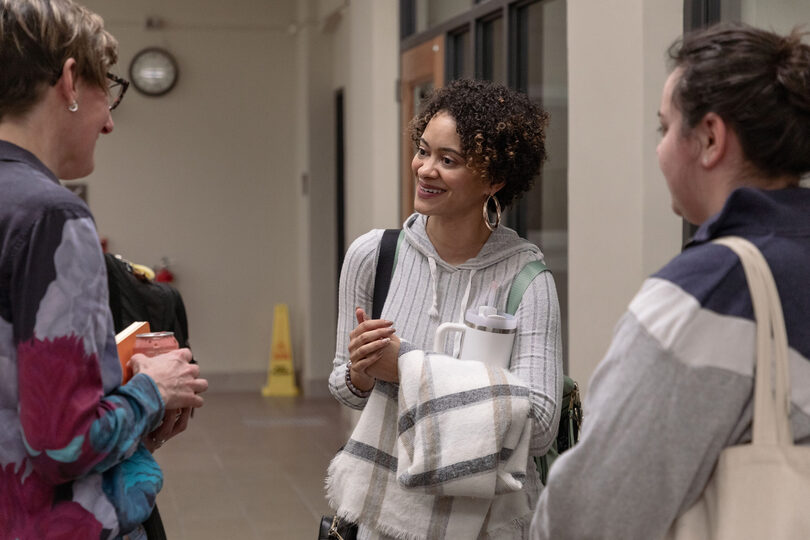‘Snatching Joy: A Radical Black Feminist Digital Praxis’ event ties digital culture to Black joy

Catherine Knight Steele presents “Snatching Joy: A Radical Black Feminist Digital Praxis,” drawing from her book and article. Her work is committed to forging new directions in Black feminist thought and insists on the power of Black joy. Joe Zhao | Assistant Photo Editor
Get the latest Syracuse news delivered right to your inbox.
Subscribe to our newsletter here.
Nearly 100 Syracuse University students, professors and administrators packed into Carnegie Library for a discussion led by Catherine Knight Steele, an assistant professor of communication at the University of Maryland. As attendees took their seats, Steele began her presentation focused on Black women and their resistance in marginalized digital communities.
The event on Tuesday night was titled “Snatching Joy: A Radical Black Feminist Digital Praxis.” Invited by Syracuse University’s Department of Communication and Rhetorical Studies (CRS), Steele discussed her book “Digital Black Feminism” and article “Radical Intentionality.”
Steele has studied historically marginalized groups and how they use technology to fight oppression since receiving her Ph.D. at the University of Illinois Chicago. She’s now in the process of her third book addressing the issue of minimal research on Black women in the media.
Throughout Steele’s speech, she described how digital culture affects Black joy. One of the book’s main topics, “Snatching Joy,” is a term Steele coined to describe how online communities, specifically belonging to Black women, cultivate joy in the digital world despite racial bias.
Steele expressed concern regarding AI, which limits the possibilities for online Black communities to experience joy by exacerbating societal biases, and forces Black women to face injustices by “snatching” their joy back.
“If we let go of this notion that things have to be collegially respectable… and that justice sometimes doesn’t look like following the letter of the law, then we can better understand some of the practices that Black women historically have employed to take back what belongs to us,” Steele said.
Examples of injustices online include facial recognition software that can incorrectly match Black individuals and racial bias through algorithms on TikTok or other media platforms. Addison Rae, a popular TikToker, rose to fame on the platform for her dancing skills. But as Steele points out, all dances performed by Rae were originally choreographed by a Black woman.
Ryan Tabrizi, a CRS assistant teaching professor who attended the event, said societal biases also affect the structure of digital platforms.
“When we’re thinking about technology, sometimes we just think that it is its own autonomous thing. Like it’s advancing, literally because it has the will to advance. That’s obviously not true,” Tabrizi said.
The CRS department prioritizes teaching students how to recognize and discuss hidden biases in technology and artificial intelligence, said CRS department chair Rachel Dubrofsky. She added that emerging technologies pose new possibilities and many challenges for Syracuse’s upcoming graduates. Micron Technology, a memory chip producer, is also beginning construction on its Syracuse site this year, offering numerous opportunities for engineering graduates.
“I think we sometimes forget that all of those people who are going to be working for Micron, also have to have communication skills, they have to be able to think creatively, they have to be problem solvers,” Dubrofsky said.
Steele said the first step towards digital solutions is for individuals, including Syracuse students, to recognize larger social issues in the real world, like the ones she discussed Tuesday.
As students continue to learn about these underlying cultural biases in digital media culture classes, they will be better equipped to recognize and understand how we can assess this technology and make it better, Tabrizi said.
“Technology won’t save us, right, we can’t invent or craft or technologize our way out of social issues and social constructs,” Steele said. “With that being said, we can mitigate harm using some technologies and tools… and we can try to focus our attention actively and as a society on some of these really stark problems that are at the foundation of our country and our culture.”





